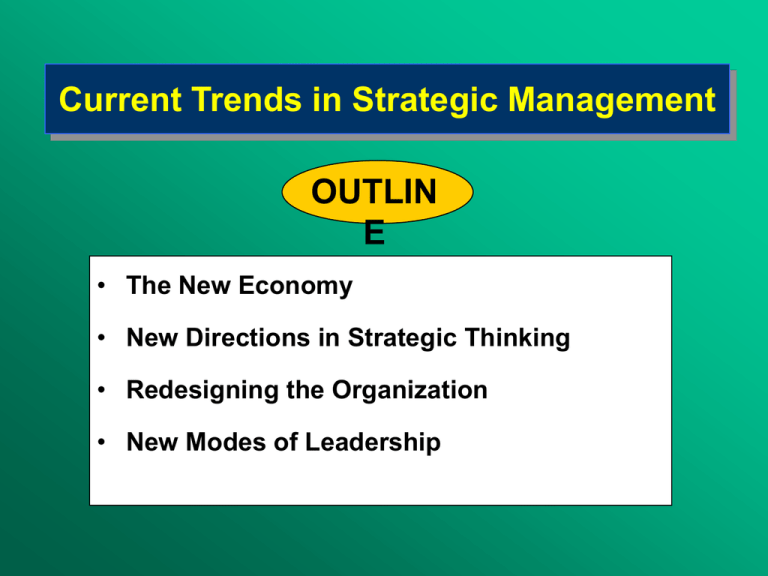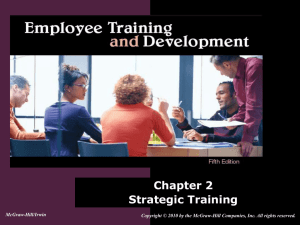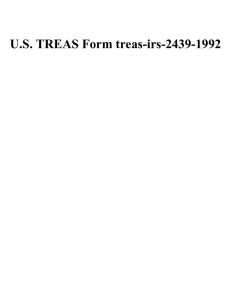Ch.17
advertisement

Current Trends in Strategic Management OUTLIN E • The New Economy • New Directions in Strategic Thinking • Redesigning the Organization • New Modes of Leadership The Turbulent 21st Century Collapse of New Economy Corporate Scandals • Enron, WorldCom, Parmalat • Jack Welch’s retirement package •Dot.com bubble bursts •TMT recession International competition intensifies • China as Workshop of the World • Outsourcing to LDCs The Curse of Terrorism • Sept. 11, 2001 •Suicide bombings in Israel, Iraq, Saudi Arabia, Turkey, Afghanistan Decline of Multilateralism War • Invasion of Afghanistan & Iraq •Civil wars in Congo, Liberia, Sudan, Somalia •Collapse of Doha round • Trade wars between US, EU, China •Weakening of UN Unstable Currencies US$ declines by >50% against Euro 2002-04 Age of Disbelief Fear of Disease •SARS, Mad Cow, Bird Flu US Labor Productivity: Annual Changes in Non-Farm Output per Hour Worked, 1990-2006 4.5 4 Annual produc t iv it y growt h (% ) 3.5 3 2.5 2 1.5 1 0.5 0 1990 1991 1992 1993 1999 2000 2001 2002 2003 2004 2005 2006 Return on Equity of US Manufacturing Corporations, 1990-2003 18 16 14 12 10 ROE (%) 8 6 4 2 0 1990 1991 1992 1993 1994 1995 1996 1997 1998 1999 2000 2001 2002 2003 Source: US Bureau of the Census The value of mergers and acquisitions worldwide 4.5 4 3.5 3 2.5 $ trillion 2 1.5 1 0.5 0 1990 1992 1994 1996 1998 2000 2002 Source: Thomson Financial Securities Data Directions in Strategic Management Practice—Trends of the 1990s Key Trends of the 1990s: •Quest for shareholder value •Adjusting to increased turbulence & more intense competition Influential Strategy Concepts: •Modern financial analysis —shareholder value, economic profit, option theory •Core competences and intangible assets •Dynamically competitive markets —“hypercompetition” •Competitive advantage through alliances, networks, and standards Major Themes of Business Strategy: •Cost cutting—squeezing overhead, business process reengineering, increasing labor productivity •Outsourcing/refocusing/ divestment •Performance management and incentive alignment Forces Shaping Company Strategies 2001-04 Future Sources of Profit Limits of downsizing/cost cutting Where are future sources of profit? Concepts & Theories The Business Environment •Uncertainty •Stalling of economic liberalization •Intense competition Technology •Resources & capabilities as Continued advances in ICT basis for competitive advantage •Knowledge-based theory of the firm Demands of society •Option theory •Social & environmental responsibility •Complexity theory •Ethics & fairness •Quest for meaning Emerging Developments STRATEGY •Multiple competitive advantages/multiple capabilities •Innovation / New Product Development / New Business Development •Alliances & networks MANAGEMENT SYSTEMS • Knowledge management (incl. best-practice transfer) • Redesigning incentive systems • Rethinking performance management • Capturing human creativity ORGANIZATION STRUCTURE • Reconciling flexibility & integration • Modular structures • Multidimensional structures • Informal organization & self-organization The Need to Redesign Organizations THE PAST Emphasis on control THE FUTURE Emphasis on co-ordination Single performance goal Multiple performance goals Decisions located centrally Decisions located where relevant knowledge exists Simple structures, unified line of command Multidimensional structures Diffused authority, but clear responsibilities Organization by design Self organization Emerging Organizational Forms Organizing for capability development Shifting emphasis of organization design from control to coordination From unitary to parallel structures Separate coordination structures for different processes. E.g. 3M’s product development structure; separate structures for TQM and change management Process-based organizations Organizing around business processes Organizing around corporate processes - entrepreneurial process - competence building process - renewal process Project-based organization E.g. engineering cos., consulting firms, also manufacturing cos. e.g. Oticon Network and virtual organization E.g. electronics in Silicon Valley, clothing and packaging equipment in Italy New Models of Leadership: What Competencies do Top Managers Need? THE LEADERSHIP NEEDS OF ORGANIZATIONS The ability to: • • • • • • • build confidence build enthusiasm cooperate deliver results form networks influence others use information THE REQUIRED COMPETENCIES OF BUSINESS LEADERS • business literacy • creativity • cross-cultural effectiveness • empathy • flexibility • proactivity • problem-solving • relation-building • teamwork • vision

